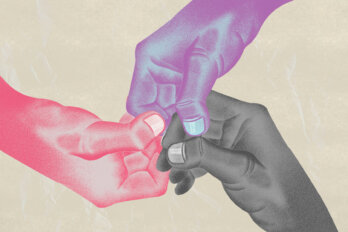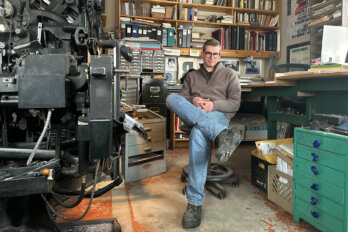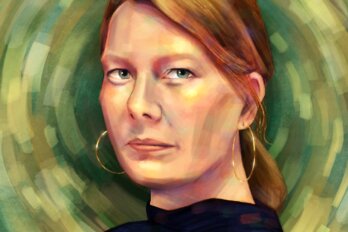Gilbert drove the kids from the reserve into town for school every morning, and sometimes when we would come to visit, he would drive another lap around the reserve to pick up all the Elders in his yellow and black bus, driving us to the treatment center or out to the community trapline on the edge of the reserve. I was in my mid-twenties. Young. I didn’t yet know which things in life are rare and which things happen all the time if you remain open and happen to be in the right place at the right time. Over two years, spending time with a group of twenty-five Elders who had known each other and their land for their entire lives was an extremely rare situation. One that in the next twenty years of my life wouldn’t be repeated with the same depth.
I’ve gone back to this experience over and over again in my head and in my writing because it changed the way I think in a fundamental way. It changed the way I am in the world. I want to reconsider it here because this experience is foundational to my work on resurgence and to who I have become. I considered parts of this story in the short story “lost in the world where he was always the only one,” published in Islands of Decolonial Love, although somewhat fictionalized, as a way of linking our current reality to the Nishnaabeg sacred story of a little boy who is taken to the skyworld to learn from seven Elders and then returned to the earth to share his new knowledge with the Nishnaabeg. Meaning, we all have to be, in some way, that little boy. Like that boy, those Elders that I learned from for those two years actually gave me something that has propelled my writing and thinking ever since. It was the greatest gift.
I was working with professor Paul Driben, an anthropologist from Lakehead University, at the time. We had been hired by the Effects on Aboriginals from the Great Lakes Environment (EAGLE) project of the Assembly of First Nations (AFN) to work with the Anishinaabeg reserve community of Long Lake #58, located in the boreal forest of northern Ontario, about three-hundred kilometres northeast of Thunder Bay, to create a landuse atlas. The band council sent us to the Elders. This was not a unique project in the 1980s and 1990s. Traditional ecological knowledge was in its heyday in the eyes of white policy-makers, academics, and even Aboriginal organizations. The idea was that if we documented on paper the ways that we use the land, policy-makers would then use the information to minimize the impacts of development on our lands and ways of life. The idea was that clearly documented land use would bring about less dispossession, as if dispossession occurs by accident or out of not knowing, rather than being the strategic structure it is. The project was to gather the individual cognitive, territorial maps Elders held in their heads into a collective, a visual remapping and translation of some aspects of Indigenous knowledge into a form that would be recognized by industry and the state.
Of course, I don’t think the Elders involved in these studies were naive. I think what I saw, and perhaps what they saw, was a process that could be used as a tool to generate cohesion, pride, and rebuilding within our own communities when our own people saw visually and so clearly what dispossession, displacement, encroachment, and industrial extractivism look like over our territories across time. Laid out in a visual way, the magnitude of the loss cannot be explained away, the strategic nature of colonialism cannot be ignored. The driving force of capitalism in our dispossession cannot be denied.
I was suspicious of Dr. Driben in the beginning. He wasn’t Native, he was an anthropologist of all things, but he had created these maps before with other Nishnaabeg communities. Sitting in his windowless cement office in the basement of a building at Lakehead University eating subs, I could tell by the details on the maps that Elders trusted him. I could tell by the bunker-like nature of his office far removed from the upper echelons of the university that perhaps the university didn’t. This boded well for our relationship.
Paul did something that has stayed with me and has always informed my approach to working with communities and to research. He was invited into the community to do a specific task, which in the end he did, but he actively and continually divested himself of the false power the academy bestowed upon him when he drove onto the reserve. He asked the Elders if they thought the project was a good idea. They said it was. He asked them how best to proceed. They told him. He asked them if they would be the decision makers. They agreed, and then they were, and he got out of their way.
This was an overwhelmingly different way of conducting research than I had experienced in two biology degrees. At the time, I could only frame it within collaborative or participatory or community-based methodologies, but it was really none of those. Those kinds of methodologies to some degree privileged Western theories, epistemologies, or knowledge systems, and the process that emerged in this situation was Nishnaabeg to the core. These methodologies assume there is a role for the academic. Paul did not. He came into their circle on the terms of the experts, the Nishnaabeg Elders, not the other way around.
Which enabled me to come into their circle, as a young Nishnaabeg person with very few useful skills to them other than youth. Western education does not produce in us the kinds of effects we like to think it does when we say things like education is the new buffalo. We learn how to type and how to write. We learn how to think within the confines of Western thought. We learn how to pass tests and get jobs within the city of capitalism. If we’re lucky and we fall into the right programs, we might learn to think critically about colonialism. But post-secondary education provides few useful skill sets to those of us who want to fundamentally change the relationship between the Canadian state and Indigenous peoples, because that requires a sustained, collective, strategic long-term movement, a movement the Canadian state has a vested interest in preventing, destroying, and dividing. Post-secondary education provides very few skill sets to those who want to learn to think in the most complex ways possible within the networked system of Indigenous intelligence. In fact, I needed to leave all of that kind of education behind in order to come into this with hesitation and an open heart. The parts of me that I drew on in this circle of Elders were liabilities at university—gentleness, humility, carefulness, and the ability to proceed slowly.
During the next two years, the Elders, who in my memory are now eagles, took me under their wings. I wrote down on large topographical maps every place name for every beach, bay, peninsula, and island they could remember—hundreds and hundreds of names. We marked down all of their traplines, and the ones before that and the ones before that. We marked down hunting grounds and fishing sites, berry patches, ricing camps, and medicines spots. We marked down birthplaces and graves. We marked down places where stories happened. We marked down ceremonial sites, places where they lived, places where life happened. We also marked down the homes of their relatives—places where moose and bears lived, nesting spots and breeding grounds. We marked down travel routes, spring-water spots, songs and prayers. Places where feet touched the earth for the first time. Places where promises were made. The place where they blocked the tracks during the summer of the so-called Oka Crisis.
We also recorded pain. The prisoner-of-war camp, the internment camp, and its school that some Nishnaabeg kids attended so they could continue to live with their families and not go to residential school. The 150 years of clearcuts. The hydroelectric dams, the direction the lake was supposed to flow. The flood, the road, the railway tracks, the mines, the pipeline, the hydro lines. The chemical sprays, the white-people parks and campgrounds. Deaths.
The overlays showed decade after decade of loss. They showed the why.
Standing at the foot of a map of loss is clarity.
Colonialism or settler colonialism or dispossession or displacement or capitalism didn’t seem complicated anymore. The mess I was wrapped in at birth didn’t seem so inevitable. It seemed simple. Colonizers wanted the land. Everything else, whether it is legal or policy or economic or social, whether it was the Indian Act or residential schools or gendered violence, was part of the machinery that was designed to create a perfect crime—a crime where the victims are unable to see or name the crime as a crime.
But this isn’t even the most important thing I learned from the Elders of Long Lake #58 in the middle of the 1990s. They gifted me with my first substantial experience with Nishnaabeg thought, theory, and methodology in a research context, and Nishnaabeg intelligence in life context. Paul showed me the kind of researcher I thought I wanted to be, but in reality, I wanted to be able to think like those Elders, not him. By taking such a radically different approach to both community and research, Paul divested his power and authority as an academic that had been placed on him by the academy and then by an Aboriginal organization and placed that responsibility where it belonged: with the leaders and the intellectuals of the community. Paul was a holder of space. He created the space for Elders to not just say the prayer and smudge us off at the beginning of the meeting but to be the meeting. He created the space to put Nishnaabeg intelligence at the center and to use its energy to drive the project. Those Elders gave me my first glimpse of Nishnaabeg brilliance—theory, methodology, story, ethics, values all enmeshed in Nishnaabeg politics and encircled by the profound influence of the world. They pulled me into an alternative Nishnaabeg world existing alongside the colonial reality I knew so well. This has propelled my life.
This experience more than anything else opened my mind and heart to the brilliance and complexity of Nishnaabeg embodied thought. It resonated in a profound way in me and has driven two decades of living, making, writing, and research. Sometimes it is the only thing I am absolutely sure of, and more than that, I am absolutely sure that we as Nishnaabeg cannot survive as a people without creating generations of artists, thinkers, makers, and doers that live in Nishnaabeg worlds that are in respectful relationship with each other, that create a movement that joins us to other Indigenous nations to protect the land and bodies. We need to live deliberately and with meaning.
I think about the maps those Elders carried in their bodies as two-dimensional representations of the networks they live and their parents and grandparents lived. I think about the maps my generation carries in our heads or maybe in our phones. I think about the networks the next generation will carry in their bodies. I think about how the networks we have in our heads today create the networks our children have in their heads as adults. It is this experience more than any others that has led me to center Nishnaabeg intelligence in my life, in my work, and in my thinking about resurgence.
Years later, when I would begin thinking and writing about Indigenous resurgence as a set of practices through which the regeneration and re-establishment of Indigenous nations could be achieved, the seeds those Elders planted in me would start to grow with a strong feeling, more than thinking, that the intellectual and theoretical home of resurgence had to come from within Indigenous thought systems, intelligence systems that are continually generated in relationship to place. I realized that the Elders of Long Lake #58 had pulled me into an Nishnaabeg world and that this world was a very fertile place for dreaming, visioning, thinking, and remembering the affirmative Indigenous worlds that continue to exist right alongside the colonial worlds. I got a strong sense from them that our intellectual systems are our responsibilities, that they are an extension of our bodies and an expression of our freedom. There was no room in their Nishnaabeg world for the desire to be recognized and affirmed by the colonizer. There was no room in their Nishnaabeg world to accommodate or centre whiteness.
The Nishnaabeg brilliance those Elders pulled me into was profound. Their world—a cognitive, spiritual, emotional, landbased space—didn’t recognize or endlessly accommodate whiteness, it didn’t accept the inevitability of capitalism, and it was a disruption to the hierarchy of heteropatriarchy. Thinking about it now, I see that it was my first flight path out of settler colonialism. In their very quiet, non-demonstrative, and profoundly gentle way, those Elders refused settler colonialism, driving along the TransCanada in a children’s school bus, laughing all the way to their trapline. They refused and generated something different. Every day. Just like their ancestors and their ancestor’s ancestors.





